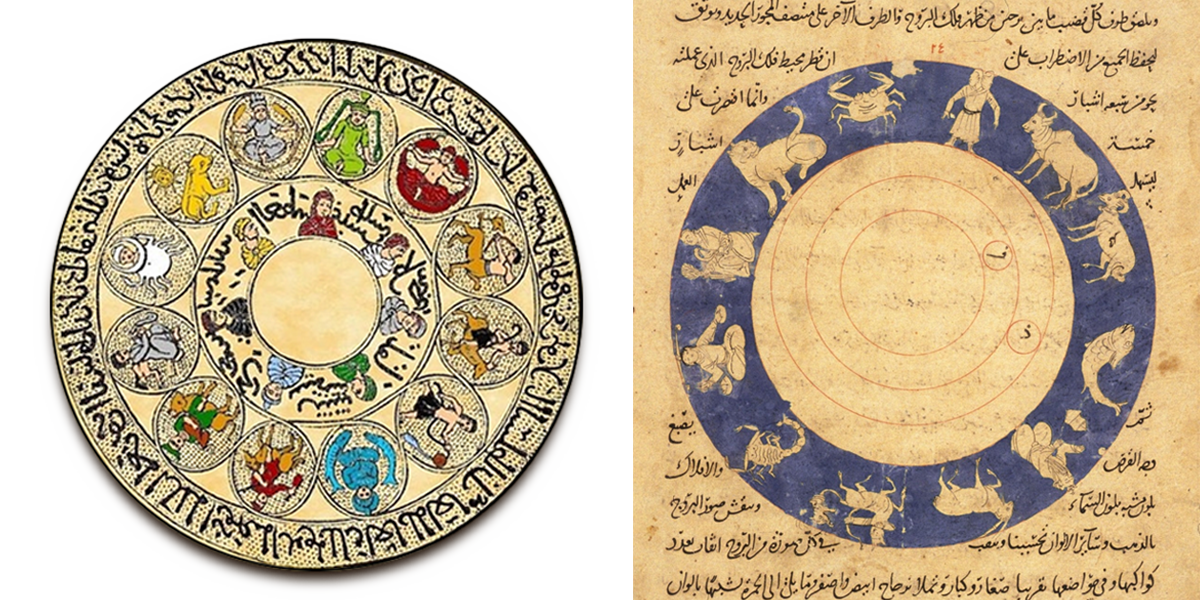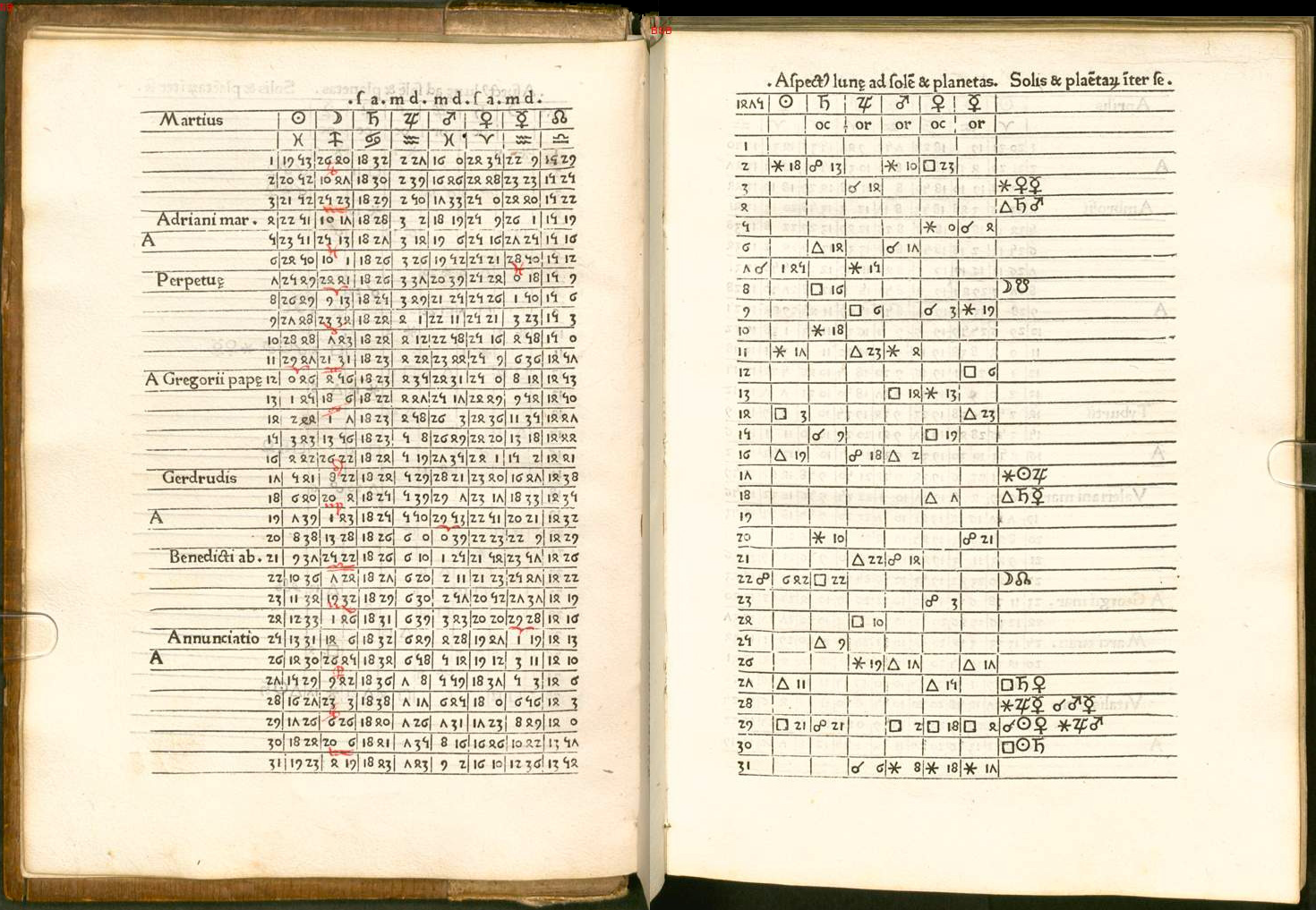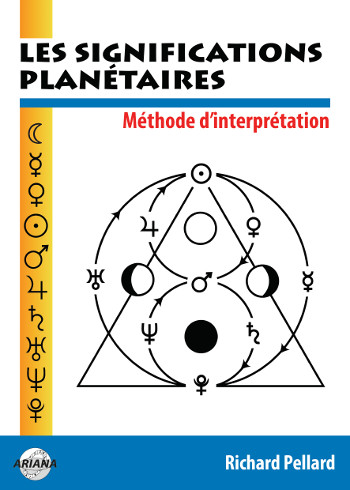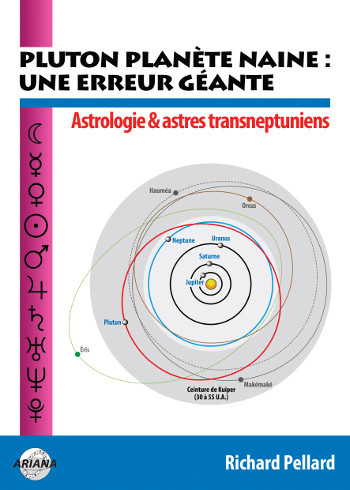Your Planets
Portraits of the Planets
Aspects between Planets
The planetary ages
The planetary families
Planets in Signs
The Planets in comics



For more than 2500 years astrologers have had only one concept intuitive and empirical of what the objective reality of an Aspect is. They confined themselves to observing empirically certain real effects and imagining unreal ones. Very rare and very embryonic have been the attempts at conceptualization and therefore at theorization, such as that exposed by Ptolemy in the 2nd century and that proposed by Kepler in the 17th. Both resulted in erroneous explanations and failures. It is only in the 20th century that the concept of Aspect began to be truly elaborate, making it possible to distinguish the true from the false in the antique and traditional notions and formulate a rational explanatory theory through an overall conception of astrology. The contemporary design and graphical representation of the Aspects are the product of a long history, and the very idea of Aspect has evolved over the millennia.
Two hundred years after Ptolemy, astrology had gradually fallen into disuse in the Roman-Christian West, serious European astrologers and researchers became extremely rare between the 4th and the 13th century, and have hardly left any traces. There was now more concern for the salvation of his crucified soul than for the status of the astrological Aspects. So we don’t know roughly when it started transition from zodiacal angles to planetary aspects. What is almost certain, however, is that the Arab and Persian astrologers-astronomers, newly converted to Islam, played a leading role in this transition.
Indeed, from 7th to the 13th century, over the course of its warlike conquests, Islamic civilization appropriated the heritage of all the cultures it subjugated, and astrology therefore fell, along with astronomy, into its cognitive purse. The Tetrabiblos and the Almagest of Ptolemy, as well as many texts of Greek scholars, who disappeared into the black hole of medieval ignorance in Europe, were translated into Arabic during the 8th-9th centuries. And during this brief “islamic golden age”, it was Muslim scholars who largely ensured the continuity of the Ptolemaic heritage in all its fields (astrology, astronomy, mathematics, geometry, optics, cartography, musicology) in the territories conquered by the jihad in Western Europe.
It should be noted in passing that these texts from Greco-Roman antiquity were indeed saved and transmitted by Muslim scholars in the European territories occupied by the Islamic armies. But he is fake to affirm that these scholars had exclusivity the safeguarding and transmission of these texts, which were also preserved and commented on, including those of Ptolemy, by the Christian scholars of the Greco-Roman Christian Empire “Byzantine” well before and well after this period of Islamist conquests and occupations. It is indeed estimated that the three quarters of the Greek classics now known come from copies made under this Eastern Empire. During the reign of the Byzantine Emperor Manuel I (1118–1180), passionate about astronomy and astrology, the works of Ptolemy had for example been translated from ancient Greek to medieval Greek, but also from Arabic to Latin. However, only a minority of Western European scholars — and among them the learned astrologers — having cultural contacts with the Eastern Christian Empire could consult them. The others — therefore the majority — had no choice but to refer to the Arabic translations and then to those from Arabic into Latin.
In the 8th century yet, nothing new under the Sun of the pseudo-Ptolemaic Aspects. For example, the writings of Masha’allah (±740–815), one of the leading and most learned astrologer-astronomers of that time. Persian Jew in the service of Abbasids, he was associated with the creation of Baghdad in 762 so that he could choose a good astral chart of foundation. Baghdad then became a very important artistic and intellectual center with a library and a teaching center where translations of ancient Greek, Syriac and Persian texts are made, and where one can therefore study astrology according to Ptolemy.
Back to Aspects. Commenting on another event than this foundation, Masha’allah associates it with a sextile (60° angle) Sun-Jupiter, while specifying that the Sun was at that time 0° 01′ of Aries and Jupiter at 14° 36′ of Gemini, which makes an angular deviation of 74° 35′ and therefore an orb of 14° 35′ for 60° corresponding to nearly 24% of this arc of ecliptic longitude. Even being very generous in defining the maximum orb for such a “Aspect”, It’s way too much. By way of comparison, most astrologers today do not allow more than 5° for a sextile and 10 to 12° for a conjunction… Conclusion: in the 8th century, 600 years after Ptolemy, Masha’allah always referred to zodiacal angles, not planetary Aspects. And Masha’allah was not a joker, since he also wrote a treatise on the astrolabe, astronomical instrument for observation and analog calculation.
The transition between zodiacal angles and the Planetary aspects was therefore probably made later, in connection with the development and improvement of the algebra by introducing the concept of equation. We owe this last innovation to another astrologer-astronomer, Al-Khwarizmi (±780–850), Persian as Masha’allah and as a considerable proportion of Muslim scholars of the Islamic Golden Age, and whose Latinized name is perhaps the origin of the word algorithm. But another etymology maintains that it comes from the Greek “arithmos” (number). Never mind. The improvement of these mathematical techniques went hand in hand with an increased demand for accuracy which was (very) probably at the origin of the very gradual questioning of zodiacal angles Ptolemaic and put on the way of true planetary Aspects, if possible calculated to the nearest second of arc.

The scarcity of documented sources makes it difficult to follow this very slow evolution. We can however conjecture that the word “Aspect” would itself have for the first time been used by Muslim scholars. It is found, for example, in the Latin translation of the book Introduction to the art of judging the stars of the mathematician and astrologer of 10th century Abd al-Aziz (Alcabitius) dated around 967. The title of one of its chapters is indeed De aspectibus planetarum (“Planetary Aspects”). But the use of this term is perhaps only an effect of its translation around 1130–1140 and then of the publication of its printed version in 1473.
In any case, the occurrences of this word will become more and more numerous from the 12th century, which saw the appearance of the first translations of astrological texts from Arabic into Latin at the same time as the end of “the golden age of islam” who had been so tolerant of astrology. This is for example the case with the astronomer and astrologer Raymond of Marseilles (around 1141) who mentions in one of his writings “two planets [which] are at 10° Aries, in square Aspect (90°), unfavorable, with the Ascendant”, or in a Astrological Aspect Cheat Sheet of the 15th century dated 1337 (Vatican Library) where it is a question of “Aspectus trinus, […] Aspectus quartus, […] Aspectus sextilis”.
Let us recall here that to qualify what an Aspect is, Ptolemy only used the words “angle” and “report” or the Greek word “skhèma” (form, figure, configuration) in his work. It was then translated from Greek into Arabic, then from Arabic into Latin, and it was not until 2000, for example, that the first translation of Tetrabiblos in French from the original Greek. However, as the novelist and translator Tiphaine Samoyault points out, “the transport from one language to another, from one space-time to another, changes the form through interpretation. As the translation is a reading before being a writing, it leaves room for interpretation” (Translation and violence, Threshold 2020). This is an analytical and nuanced presentation (its very politicized author is far from always being so) of what the Italian expression “Traduttore, traditore” (“translator, traitor”) evokes in a more concise and abusive mode, as it is true that not all translations are betrayals.
It is therefore not impossible that the word “Aspect” is the creation of a scientist monk copyist and translator of Toledo of the 12th century, this Spanish city which lived for more than 3 centuries under the Muslim yoke being then a renowned translation center…
In his treatise on astrology The beginning of wisdom, written in the middle of the 12th century, the Andalusian astronomer-astrologer, mathematician, rabbi and philosopher Abraham ibn Ezra (1092–1167) seems to be situated, in his conception of the Aspects, halfway between the zodiacal angles and the planetary Aspects. Indeed, this scientist measures the Aspects there according to the number of arc degrees between two planets, which is huge progress, but he still ignores it if they don’t find each other at the same time in zodiacal angles. He thus considers, for example, that a square (dissonant Aspect of 90°) between Venus at 1° Libra and Saturn at 3° Capricorn is effective because these Signs are in a dissonant relationship, but he does not count the same Aspect between Venus at 1° Libra and Saturn at 29° Sagittarius because these Signs are in consonant relationship, while there is only 2° of orb between these two zodiacal versions of the same planetary Aspect. But Abraham ibn Ezra, if he gained in precision on the definition of the Aspects in the ecliptic longitudes, does not mention orbs, for him the effects of the zodiacal angles remain preponderant.
Abraham ibn Ezra is also concerned with ecliptic latitudes, in the same vein as Ptolemy, when he writes about the deadly directions that “Whether the anerete has no latitude, he will cut off life when he arrives on the Sun, on the rising degree […] and also on the Moon if it has no latitude, or if it has the same latitude as that Saturn or Mars, and whether they are on the same side of the ecliptic. If they are on either side of the ecliptic, they indicate disease and not death, and the intensity of the disease will depend on the greater or lesser difference in latitude between the two: the smaller the distance, the more intense the disease. Know that if Saturn or Mars have a latitude, whether high or low, whether north or south [of the ecliptic], they will never slice life.” It will be noted on this subject that, like Ptolemy who is one of his major references, Ezra is only concerned with latitudes when he mentions forecasting techniques.
In the 13th century, the Italian astronomer-astrologer Guido Bonati (1210–1296) develops in his treatises on astrology the same conception of the Aspects as Abraham ibn Ezra, but he differs from him by his clear reference to orbs. Like him, he therefore only admits, for example, a conjunction between two planets if they are in the same sign. But he is the first to evoke the notion of “burnt planet”, which designates according to him any planet located in an orb of 15° before and 15° after the Sun, whose heat would burn it until annihilating its influence or making it very malefic — which means that a conjunction can also be “malefic”, contrary to what Ptolemy thought. This notion of “combustion” was of course a nonsense, but it should be noted that the total orb allowed for this imaginary solar carbonization effect is still 30°! Another less significant example of an admitted orb: Bonati estimates that the Moon is afflicted when it is located in an orb of less than 12° from its North or South nodes. Bonati was probably not the precursor of the orbs, but he was the first notable astrologer to systematically mention them in his writings passed to posterity.
We find this notion of orb in Henricus de Geislingen, an obscure German astrologer of the 15th century about which we know almost nothing, except that in a manuscript about predictions for the date of 26/06/1405, he mentioned the existence of a conjunction of Jupiter at 23° Pisces with Mars at 2° Aries. This mention signifies on the one hand that he admitted an orb of about 11° for this Aspect, and on the other hand that it considered efficient when it was between two adjacent Signs. He therefore seemed to have freed himself from the tyranny of the Ptolemaic doctrine of zodiacal angles, according to which a conjunction was admitted only if it occurred in the same Sign. Henricus de Geislingen was probably not the only one to have had this audacity, but no source confirms this.
The invention of typographic printing in the 15th century saw the appearance and spread of raw astronomical tables, which makes the first historical tracing of the notion of Aspect easier. The documents of this time show that their calculation gave rise to debates between those who advocated calculation of the arithmetic deviation between two planets, therefore planetary Aspects properly speaking, and those, majority, who preferred the geometric method of Ptolemy, so the zodiacal angles. In any case, this is what emerges from all the first annual prediction almanacs of this time.
The few supporters of the calculation of arithmetic deviations, they were divided between those who opted for their calculation on the fixed sphere (stars), so probably taking into account the ecliptic latitudes planets, and those who preferred to stick to only longitudes, who were the most numerous. We do not find traces of any debate on the extent of the admitted orbs, but they must probably have existed among specialists and researchers, if we refer to the case of Henricus de Geislingen.
The image below represents two pages of an ephemeris of Regiomontanus (1436–1476), German astrologer, astronomer and mathematician who is, among other things, the official author of a house-building method which bears his name but was invented by Ibn Ezra. The left page lists the positions of the 7 planets known at the time as well as that of the North Node of the Moon. The one on the right provides information on the exact Aspects (according to calculations at the time, which were not always accurate) corresponding to these positions with the exception of the lunar Aspects.

We can therefore see that astrologers took a very long time to question the zodiacal angles Ptolemaic and to take into account orbs, whose definition of admissible and arithmetically calculated extents was going to occupy them during a few centuries…
However, the game was still far from won for the true planetary Aspects and their orbs. In effect the attribution of the 4 Elements (Fire, Earth, Air, Water) to the zodiac, then later to the Planets, occurred towards the end of the Middle Ages, even in the 15th century with the rediscovery of ancient Greco-Roman knowledge sparked by the Renaissance. While they have so far been absent from corpus of astrological knowledge, since Ptolemy made no reference to them, this late irruption of the 4 Elements put a coin back in the jukebox of the zodiacal angles, the ancient gender distinctions between Signs changing into distinctions between Elements. It was kind of always the same music from the same old song, but with new lyrics from Fire, Earth, Air and Water. Johannes Kepler tried, in vain, to put an end to it in the 17th century by replacing it with music of his spheres…
▶ Aspects theory and practice
▶ Les aspects, phases d’un cycle
▶ Aspects : existe-t-il un modèle traditionnel ?
▶ Aspects : théorie et bilan conditionaliste
▶ Introduction à l’interprétation des aspects
▶ The planetary Aspects and their orbs
▶ Les Aspects kepleriens
▶ Les “aspects” aux Angles
▶ Chronologie des Aspects et Transits
▶ Les Aspects planétaires

Les significations planétaires
par
620 pages. Illustrations en couleur.
La décision de ne traiter dans ce livre que des significations planétaires ne repose pas sur une sous-estimation du rôle des Signes du zodiaque et des Maisons. Le traditionnel trio Planètes-Zodiaque-Maisons est en effet l’expression d’une structure qui classe ces trois plans selon leur ordre de préséance et dans ce triptyque hiérarchisé, les Planètes occupent le premier rang.
La première partie de ce livre rassemble donc, sous une forme abondamment illustrée de schémas pédagogiques et tableaux explicatifs, une édition originale revue, augmentée et actualisée des textes consacrés aux significations planétaires telles qu’elles ont été définies par l’astrologie conditionaliste et une présentation détaillée des méthodes de hiérarchisation planétaire et d’interprétation accompagnées de nombreux exemples concrets illustrés par des Thèmes de célébrités.
La deuxième partie est consacrée, d’une part à une présentation critique des fondements traditionnels des significations planétaires, d’autre part à une présentation des rapports entre signaux et symboles, astrologie et psychologie. Enfin, la troisième partie présente brièvement les racines astrométriques des significations planétaires… et propose une voie de sortie de l’astrologie pour accéder à une plus vaste dimension noologique et spirituelle qui la prolonge et la contient.
Téléchargez-le dès maintenant dans notre boutique

Pluton planète naine : une erreur géante
par
117 pages. Illustrations en couleur.
Pluton ne fait plus partie des planètes majeures de notre système solaire : telle est la décision prise par une infime minorité d’astronomes lors de l’Assemblée Générale de l’Union Astronomique Internationale qui s’est tenue à Prague en août 2006. Elle est reléguée au rang de “planète naine”, au même titre que les nombreux astres découverts au-delà de son orbite.
Ce livre récapitule et analyse en détail le pourquoi et le comment de cette incroyable et irrationnelle décision contestée par de très nombreux astronomes de premier plan. Quelles sont les effets de cette “nanification” de Pluton sur son statut astrologique ? Faut-il remettre en question son influence et ses significations astro-psychologiques qui semblaient avérées depuis sa découverte en 1930 ? Les “plutoniens” ont-ils cessé d’exister depuis cette décision charlatanesque ? Ce livre pose également le problème des astres transplutoniens nouvellement découverts. Quel statut astrologique et quelles influences et significations précises leur accorder ?
Enfin, cet ouvrage propose une vision unitaire du système solaire qui démontre, chiffes et arguments rationnels à l’appui, que Pluton en est toujours un élément essentiel, ce qui est loin d’être le cas pour les autres astres au-delà de son orbite. Après avoir lu ce livre, vous saurez quoi répondre à ceux qui pensent avoir trouvé, avec l’exclusion de Pluton du cortège planétaire traditionnel, un nouvel argument contre l’astrologie !
Téléchargez-le dès maintenant dans notre boutique